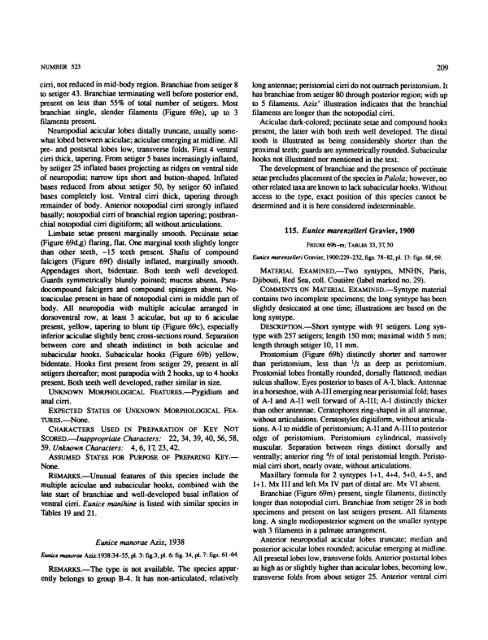A Review of the Genus Eunice - Smithsonian Institution Libraries
A Review of the Genus Eunice - Smithsonian Institution Libraries
A Review of the Genus Eunice - Smithsonian Institution Libraries
Create successful ePaper yourself
Turn your PDF publications into a flip-book with our unique Google optimized e-Paper software.
NUMBER 523 209<br />
cirri, not reduced in mid-body region. Branchiae from setiger 8<br />
to setiger 43. Branchiae terminating well before posterior end,<br />
present on less than 55% <strong>of</strong> total number <strong>of</strong> setigers. Most<br />
branchiae single, slender filaments (Figure 69e), up to 3<br />
filaments present<br />
Neuropodial acicular lobes distally truncate, usually somewhat<br />
lobed between aciculae; aciculae emerging at midline. All<br />
pre- and postsetal lobes low, transverse folds. First 4 ventral<br />
cirri thick, tapering. From setiger 5 bases increasingly inflated,<br />
by setiger 25 inflated bases projecting as ridges on ventral side<br />
<strong>of</strong> neuropodia; narrow tips short and button-shaped Inflated<br />
bases reduced from about setiger 50, by setiger 60 inflated<br />
bases completely lost. Ventral cirri thick, tapering through<br />
remainder <strong>of</strong> body. Anterior notopodial cirri strongly inflated<br />
basally; notopodial cirri <strong>of</strong> branchial region tapering; postbranchial<br />
notopodial cirri digitiform; all without articulations.<br />
Limbaic setae present marginally smooth. Pectinate setae<br />
(Figure 69d,g) flaring, flat. One marginal tooth slightly longer<br />
than o<strong>the</strong>r teeth, -15 teeth present. Shafts <strong>of</strong> compound<br />
falcigers (Figure 690 distally inflated, marginally smooth.<br />
Appendages short, bidentate. Both teeth well developed.<br />
Guards symmetrically bluntly pointed; mucros absent Pseudocompound<br />
falcigers and compound spinigers absent Notoaciculae<br />
present in base <strong>of</strong> notopodial cirri in middle part <strong>of</strong><br />
body. All neuropodia with multiple aciculae arranged in<br />
dorsoventral row, at least 3 aciculae, but up to 6 aciculae<br />
present, yellow, tapering to blunt tip (Figure 69c), especially<br />
inferior aciculae slightly bent; cross-sections round. Separation<br />
between core and sheath indistinct in both aciculae and<br />
subacicular hooks. Subacicular hooks (Figure 69b) yellow,<br />
bidentate. Hooks first present from setiger 29, present in all<br />
setigers <strong>the</strong>reafter; most parapodia with 2 hooks, up to 4 hooks<br />
present. Both teeth well developed, ra<strong>the</strong>r similar in size.<br />
UNKNOWN MORPHOLOGICAL FEATURES.—Pygidium and<br />
anal cirri.<br />
EXPECTED STATES OF UNKNOWN MORPHOLOGICAL FEA-<br />
TURES.—None.<br />
CHARACTERS USED IN PREPARATION OF KEY NOT<br />
SCORED.—Inappropriate Characters: 22, 34, 39,40, 56, 58,<br />
59. Unknown Characters: 4,6, 17, 23,42.<br />
ASSUMED STATES FOR PURPOSE OF PREPARING KEY.—<br />
None.<br />
REMARKS.—Unusual features <strong>of</strong> this species include <strong>the</strong><br />
multiple aciculae and subacicular hooks, combined with <strong>the</strong><br />
late start <strong>of</strong> branchiae and well-developed basal inflation <strong>of</strong><br />
ventral cirri. <strong>Eunice</strong> manihine is listed with similar species in<br />
Tables 19 and 21.<br />
<strong>Eunice</strong> manorae Aziz, 1938<br />
<strong>Eunice</strong> manorae Aziz:1938:34-35. pi. 3: fig.3. pi. 6: fig. 34. pi. 7: figs. 61-64.<br />
REMARKS.—The type is not available. The species apparently<br />
belongs to group B-4. It has non-articulated, relatively<br />
long antennae; peristomial cirri do not outreach peristomium. It<br />
has branchiae from setiger 80 through posterior region; with up<br />
to 5 filaments. Aziz' illustration indicates that <strong>the</strong> branchial<br />
filaments are longer than <strong>the</strong> notopodial cirri.<br />
Aciculae dark-colored; pectinate setae and compound hooks<br />
present, <strong>the</strong> latter with both teeth well developed. The distal<br />
tooth is illustrated as being considerably shorter than <strong>the</strong><br />
proximal teeth; guards are symmetrically rounded. Subacicular<br />
hooks not illustrated nor mentioned in <strong>the</strong> text.<br />
The development <strong>of</strong> branchiae and <strong>the</strong> presence <strong>of</strong> pectinate<br />
setae precludes placement <strong>of</strong> <strong>the</strong> species in Palola; however, no<br />
o<strong>the</strong>r related taxa are known to lack subacicular hooks. Without<br />
access to <strong>the</strong> type, exact position <strong>of</strong> this species cannot be<br />
determined and it is here considered indeterminable.<br />
115. <strong>Eunice</strong> marenzelleri Gravier, 1900<br />
FIGURE 69h-m; TABLES 33,37,50<br />
<strong>Eunice</strong> marenzelleri Gravier, 1900:229-232. figs. 78-82, pi. 13: figs. 68,69.<br />
MATERIAL EXAMINED.—TWO syntypes, MNHN, Paris,<br />
Djibouti, Red Sea, coll. Coutiere (label marked no. 29).<br />
COMMENTS ON MATERIAL EXAMINED.—Syntype material<br />
contains two incomplete specimens; <strong>the</strong> long syntype has been<br />
slightly desiccated at one time; illustrations are based on <strong>the</strong><br />
long syntype.<br />
DESCRIPTION.—Short syntype with 91 setigers. Long syntype<br />
with 257 setigers; length 150 mm; maximal width 5 mm;<br />
length through setiger 10,11 mm.<br />
Prostomium (Figure 69h) distinctly shorter and narrower<br />
than peristomium, less than V2 as deep as peristomium.<br />
Prostomial lobes frontally rounded, dorsally flattened; median<br />
sulcus shallow. Eyes posterior to bases <strong>of</strong> A-I, black. Antennae<br />
in a horseshoe, with A-I 11 emerging near peristomial fold; bases<br />
<strong>of</strong> A-I and A-II well forward <strong>of</strong> A-III; A-I distinctly thicker<br />
than o<strong>the</strong>r antennae. Ceratophores ring-shaped in all antennae,<br />
without articulations. Ceratostyles digitiform, without articulations.<br />
A-I to middle <strong>of</strong> peristomium; A-II and A-III to posterior<br />
edge <strong>of</strong> peristomium. Peristomium cylindrical, massively<br />
muscular. Separation between rings distinct dorsally and<br />
ventrally; anterior ring 4 /s <strong>of</strong> total peristomial length. Peristomial<br />
cirri short, nearly ovate, without articulations.<br />
Maxillary formula for 2 syntypes 1+1, 444, 5+0, 4+5, and<br />
1+1. Mx III and left Mx IV part <strong>of</strong> distal arc. Mx VI absent<br />
Branchiae (Figure 69m) present single filaments, distinctly<br />
longer than notopodial cirri. Branchiae from setiger 28 in both<br />
specimens and present on last setigers present. All filaments<br />
long. A single medioposterior segment on <strong>the</strong> smaller syntype<br />
with 3 filaments in a palmate arrangement<br />
Anterior neuropodial acicular lobes truncate; median and<br />
posterior acicular lobes rounded; aciculae emerging at midline.<br />
All presetal lobes low, transverse folds. Anterior postsetal lobes<br />
as high as or slightly higher than acicular lobes, becoming low,<br />
transverse folds from about setiger 25. Anterior ventral cirri
















